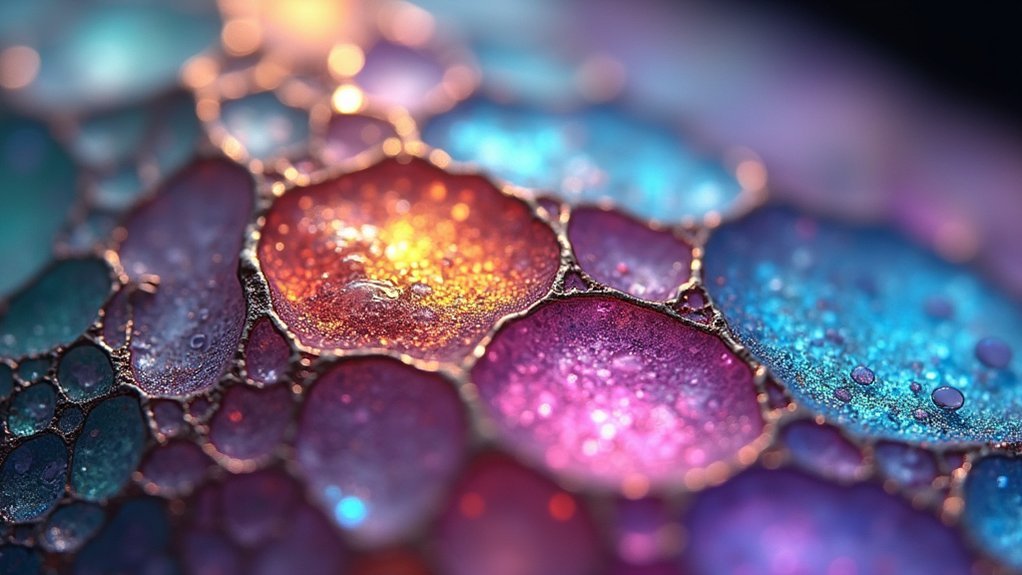Detecting gemstone treatments requires both specialized tools and trained observation skills. You’ll need magnification to spot color concentrations in cracks (dyes), iridescent films (coatings), and altered inclusions (heat treatments). Advanced techniques like IR spectroscopy, UV-Vis analysis, and laser flash testing disclose treatments invisible to the naked eye. Start with basic visual assessment before employing sophisticated instruments like FTIR and Raman systems. The following guide reveals the complete treatment detection workflow for gem professionals.
Basic Principles of Treatment Detection in Gemstones

How can you tell if that brilliant ruby or sapphire has been artificially enhanced?
Detecting gemstone treatments requires both specialized tools and trained eyes. You’ll need magnification to spot subtle signs of enhancement that aren’t visible to the naked eye.
When examining gems, look for color concentrations along cracks—a telltale sign of dye treatments.
Surface coatings often appear as an iridescent film that may wear off at facet junctions.
For heat treatment detection, you’ll need to observe internal features like altered inclusions or recrystallized structures.
Remember that some treatments, particularly beryllium diffusion and sophisticated heat treatments, require a professional gemologist’s expertise and advanced equipment like spectroscopy.
Even experienced collectors should seek laboratory verification when authentication matters most.
Spectroscopic Analysis Techniques for Enhanced Gems
While the naked eye and basic magnification can reveal some gemstone treatments, spectroscopic analysis provides definitive evidence that’s impossible to ignore.
Trust spectroscopic analysis to expose gemstone treatments that even the most careful visual inspection might miss.
When you’re examining treated gems, techniques like IR and Raman spectroscopy reveal their chemical composition, distinguishing natural from enhanced stones.
You’ll find UV-Vis spectroscopy particularly valuable for identifying heat treatments through distinctive absorption patterns.
For more complex enhancements, LA-ICP-MS detects trace elements introduced during diffusion processes, like beryllium in sapphires.
Photoluminescence spectroscopy helps you spot laser drilling in diamonds by analyzing emissions from inclusions under UV light.
Don’t overlook XRF analysis when investigating potential coatings—it quickly identifies foreign elements not naturally occurring in gemstones.
These spectroscopic analysis techniques form your definitive toolkit for authenticating gems and protecting yourself from misrepresented treatments.
Microscopic Identification of Fracture Fillings and Coatings

When examining fracture-filled gemstones, you’ll notice the distinctive laser flash effect as light reflects off the filler-stone interface at specific angles under microscopic inspection.
Coating thickness variations often appear as uneven color distribution or iridescence when you rotate the gem under magnification, revealing the artificial nature of the treatment.
You can identify disclosing bubbles trapped within fillers by using darkfield illumination, as these tiny spherical or flattened voids don’t occur in natural inclusions and serve as telltale signs of treatment.
Laser Flash Effect
The laser flash effect stands as an essential diagnostic tool in a gemologist’s arsenal for detecting hidden treatments in gemstones. When you’re examining suspicious stones, this technique allows you to identify both fracture fillings and surface coatings that might otherwise escape detection.
During microscopic examination, you’ll direct a laser beam onto the gemstone and observe how light interacts with treated areas. Fracture fillings typically reveal themselves through distinctive flash effects caused by differences in refractive index between the filling material and the surrounding gem.
Similarly, coatings display telltale irregularities or scratch patterns under laser illumination.
For best results, you’ll need specialized equipment that enhances your ability to differentiate between natural features and artificial treatments. The laser flash effect provides gemologists with conclusive visual evidence of treatments that might otherwise remain invisible.
Coating Thickness Variations
Microscopic examination reveals coating thickness variations as another key indicator of gemstone treatments. When you observe a treated stone under magnification, you’ll notice inconsistencies in how light reflects and refracts across the surface—a telltale sign of applied coatings. These variations appear distinctly different from the underlying gem material.
You can detect fracture fillings through immersion techniques and polarized light microscopy by identifying refractive index mismatches between the filling and the natural stone. Bubbles or particles within coating layers further confirm synthetic or treated origins.
For advanced detection, employ spectroscopic techniques like Raman and FTIR spectroscopy. These methods provide precise information about coating materials and their depths, allowing you to identify specific treatments with confidence and accuracy.
Disclosing Bubbles
Bubbles trapped within fracture fillings serve as definitive evidence of gemstone treatment, revealing the gemologist’s secret weapon for identifying enhanced stones.
When examining gemstones under magnification (10x or higher), you’ll notice these telltale spherical formations within glass or resin fillers—a characteristic absent in natural inclusions.
These microscopic indicators vary considerably in appearance. Larger, irregular bubbles often suggest lower-quality treatments, while smaller, uniform ones indicate more sophisticated enhancement techniques. Their presence dramatically affects both the value and durability of treated stones, particularly in diamonds and emeralds where clarity treatments are common.
During evaluations, expert gemologists must always disclose the presence of these bubbles. By identifying these distinctive features, you’ll develop the essential skills to distinguish between natural gemstones and those that have undergone fracture filling treatments.
Thermal and Chemical Testing Methods for Treated Stones

While identifying treated gemstones visually can be challenging, thermal and chemical testing methods offer reliable ways to detect modifications.
Proper gemstone testing reveals the truth behind treatments, even when visual inspection fails to expose modifications.
You’ll find that thermal testing reveals heat treatments by evaluating color and clarity changes, as treated stones respond differently to temperature than natural ones.
Chemical testing through spectroscopy detects treatment-specific elements, such as beryllium in enhanced sapphires or dyes in porous gems.
For clarity enhancements, refractive index measurements identify filling materials by their distinct optical properties.
Advanced detection methods include:
- Laser-induced breakdown spectroscopy (LIBS) for analyzing elemental composition and identifying abnormalities
- Infrared spectroscopy to detect surface coatings by revealing characteristic absorption bands
- Specialized chemical tests that respond differently to natural versus treated stone compositions
Advanced Imaging Technologies in Detecting Lattice Diffusion
Detecting lattice diffusion treatments requires sophisticated imaging technologies that can reveal atomic-level changes in gemstones. You’ll need these advanced imaging technologies to identify stones that have undergone color enhancement through artificial means.
| Technology | Detection Capability | Key Indicator |
|---|---|---|
| Photoluminescence Spectroscopy | Light emission patterns | Specific color centers |
| High-resolution SEM | Microstructural analysis | Visual penetration depth |
| EDX Spectroscopy | Elemental analysis | Trace titanium/beryllium |
FTIR spectroscopy identifies chemical changes by detecting unique absorption bands related to introduced elements. For deeper investigation, NMR spectroscopy examines the atomic environment within the gemstone’s structure, allowing you to differentiate between natural and treated stones based on chemical shift variations. These technologies provide complementary data that, when analyzed together, create a thorough profile of lattice diffusion treatments.
Differentiating Natural vs. Heat-Treated Color Origins

Beyond technical imaging approaches, the naked eye and standard gemological tools offer meaningful insights into gemstone treatment history.
When examining stones for heat treatment evidence, you’ll notice natural gemstones typically display irregular color zoning and characteristic inclusions that tell their geological story.
- Color distribution – Natural stones show variable coloration while heat-treated gemstones exhibit more uniform, often deeper hues throughout the stone.
- Inclusion patterns – Untreated gemstones contain intact inclusions whereas heat treatment can alter or heal these internal features.
- Long-term stability – Heat-treated colors remain permanent while some natural stones may gradually change with environmental exposure.
You can detect treatment history by observing these differences alongside crystal growth patterns and light behavior.
For definitive identification, spectroscopy reveals color centers unique to heat-treated stones that don’t exist in their natural counterparts.
Laboratory Equipment and Tools for Professional Detection
Professional gemstone treatment detection requires specialized equipment ranging from basic refractometers to advanced spectroscopy instruments like FTIR and Raman systems.
You’ll need to establish a methodical workflow that begins with non-destructive testing methods such as UV fluorescence examination and microscopy before proceeding to more sophisticated analysis.
Your laboratory setup should prioritize instruments that complement each other to create a thorough detection system capable of identifying multiple treatment types across various gemstone families.
Advanced Instrumentation Needs
Five essential categories of specialized equipment form the backbone of professional gemstone treatment detection.
As a gemologist seeking to identify sophisticated gem treatments, you’ll need access to advanced instrumentation that goes beyond basic testing tools.
Spectrometers and X-ray fluorescence (XRF) analyzers reveal elemental compositions that expose treatments like beryllium diffusion and irradiation by detecting trace elements absent in natural stones.
For thorough treatment detection, prioritize:
- Infrared and Raman spectroscopy systems to identify dyes and coatings through their unique absorption patterns
- High-resolution imaging equipment for detailed analysis of inclusions and surface features revealing laser drilling or fracture filling
- Refractive index measurement tools to assess clarity enhancements by comparing filler materials against the gemstone itself
Practical Detection Workflow
While identifying treated gemstones requires specialized knowledge, establishing a systematic detection workflow significantly improves accuracy and efficiency.
You’ll need to start with basic visual assessment before deploying more sophisticated tools.
Begin with advanced microscopy to examine internal features, looking for telltale signs of fracture filling or dyeing.
Follow with refractometers to measure refractive indices that might reveal coating treatments.
When these initial tests suggest treatments, employ spectrometers to analyze absorption patterns that can identify beryllium diffusion or irradiation.
For conclusive evidence, incorporate infrared spectroscopy to detect clarity-enhancing substances like oils or resins.
In complex cases, utilize elemental analysis techniques such as LA-ICP-MS to identify trace elements introduced during gemstone treatments.
This progressive workflow guarantees nothing escapes detection during your gem authentication process.
Interpreting Inclusions as Evidence of Treatment History

When examining gemstones under magnification, inclusions serve as telltale fingerprints that reveal their treatment history.
As a gemologist, you’ll notice that untreated stones typically lack certain types of inclusions that become evident in treated specimens. For example, heat treatment in corundum creates distinctive altered crystal structures, while dyeing treatments in porous gemstones like jade often concentrate colored substances along fine cracks.
To identify treatment evidence through inclusions:
- Look for gas bubbles or unusual crystal formations that indicate glass or fracture filling.
- Examine fine cracks for concentrated dyes in porous gemstones.
- Search for altered inclusion patterns in corundum that suggest heat treatment.
These microscopic features provide critical insights that help you differentiate between natural and treated gemstones, giving you confidence in your authentication process.
Frequently Asked Questions
Does Gemstone Therapy Work?
No, there’s no scientific evidence supporting gemstone therapy’s effectiveness for healing ailments. While you might experience placebo effects, you shouldn’t rely on gemstones instead of proven medical treatments for health concerns.
What Are the 5 C’s of Gemstones?
The 5 C’s of gemstones you’ll want to contemplate are Cut, Color, Clarity, Carat weight, and Certification. These factors determine quality and value when you’re evaluating or purchasing any precious gemstone.
What Is the Best Gemstone Grading System?
The GIA grading system is widely considered the best for diamonds with its 4Cs approach. For colored gemstones, you’ll find AGL and GemResearch SwissLab (GRS) offer respected standards tailored to specific stone varieties.
What Is the Best Way to Test Gemstones?
You’ll get the most accurate gemstone evaluations by using advanced spectroscopy, microscopic examination, and refractive index measurement. Don’t forget immersion techniques and laboratory equipment like UV lights and polariscopes for thorough testing.
In Summary
You’ll find that mastering gemstone treatment detection requires both technical knowledge and practical experience. As you’ve learned, advanced tools like spectroscopy and microscopy are essential, but don’t underestimate the value of your trained eye. By systematically applying these detection methods, you’ll confidently distinguish natural gems from their treated counterparts, protecting yourself and your clients from misrepresentation in the marketplace.





Leave a Reply